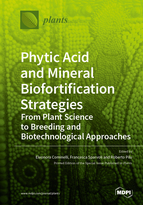Phytic Acid and Mineral Biofortification Strategies: From Plant Science to Breeding and Biotechnological Approaches
A special issue of Plants (ISSN 2223-7747).
Deadline for manuscript submissions: closed (30 November 2019) | Viewed by 67501
Special Issue Editors
Interests: seed nutritional quality; phytic acid metabolism; ABC-MRP type phytic acid transporter; lpa mutants; abiotic stresses; mineral accumulation
Special Issues, Collections and Topics in MDPI journals
Interests: legumes; Phaseolus vulgaris; seed; seed protein; seed nutritional quality; phytic acid metabolism; ABC-MRP type phytic acid transporter; lpa mutants
Special Issues, Collections and Topics in MDPI journals
Interests: breeding; molecular plant breeding; plant genetics; plant genomics; agrobiodiversity; germplasm bank
Special Issues, Collections and Topics in MDPI journals
Special Issue Information
Dear Colleagues,
Mineral deficiencies, particularly for iron and zinc, affect over two billion people worldwide, mainly in developing countries where diets are based on the consumption of staple crops. Mineral biofortification includes different approaches aimed to increase the level and/or bioavailability of minerals in the edible parts of plants, particularly the seeds.
One of the main “antinutrients” that affects mineral bioavailability is phytic acid, the main phosphorous storage form, a strong cation chelator. Different low phytic acid (lpa) mutants have been isolated in different crops and in some cases the increased mineral bioavailability from these mutant seeds was shown. Phytic acid is not only a storage compound, but also a very important signalling molecule, involved in different regulatory processes. For this reason, some lpa mutants show negative pleiotropic effects.
Another goal of biofortification is to enhance the seed mineral concentration, modulating mineral uptake, chelation and storage, without interfering with general mineral homeostasis in the plant. Different genes have been described as good candidates to reach this objective, such as genes encoding for metal transporters (i.e. vacuolar iron transporter, VIT; zinc-regulated transporter, ZRT), mineral storage proteins (i.e. Ferritin), transcription factors regulating seed mineral concentration (i.e. bHLH, bZIP, NAC) and genes involved in the synthesis of metal chelators (i.e. nicothianamine synthase, NAS).
Breeding programs or transgenic approaches aimed to develop biofortified crops should exploit basic plant science results in order to maximize the utility of the modified crops, avoiding the display of negative pleiotropic effects.
This Special Issue aims to highlight new developments in our understanding of how perturbation in phytic acid content or in seed mineral accumulation contributes to plant function, growth, and response to the environment.
Contributions to this Special Issue are invited from scientists working at all system levels, including the molecule, cell, organism and environment/ecological perspectives.
Dr. Eleonora Cominelli
Dr. Francesca Sparvoli
Dr. Roberto Pilu
Guest Editors
Manuscript Submission Information
Manuscripts should be submitted online at www.mdpi.com by registering and logging in to this website. Once you are registered, click here to go to the submission form. Manuscripts can be submitted until the deadline. All submissions that pass pre-check are peer-reviewed. Accepted papers will be published continuously in the journal (as soon as accepted) and will be listed together on the special issue website. Research articles, review articles as well as short communications are invited. For planned papers, a title and short abstract (about 100 words) can be sent to the Editorial Office for announcement on this website.
Submitted manuscripts should not have been published previously, nor be under consideration for publication elsewhere (except conference proceedings papers). All manuscripts are thoroughly refereed through a single-blind peer-review process. A guide for authors and other relevant information for submission of manuscripts is available on the Instructions for Authors page. Plants is an international peer-reviewed open access semimonthly journal published by MDPI.
Please visit the Instructions for Authors page before submitting a manuscript. The Article Processing Charge (APC) for publication in this open access journal is 2700 CHF (Swiss Francs). Submitted papers should be well formatted and use good English. Authors may use MDPI's English editing service prior to publication or during author revisions.
Keywords
- biofortification
- low phytic acid (lpa) mutants
- metal chelators
- metal transporter
- mineral deficiencies
- mineral storage protein
- phytic acid
- signal transduction








